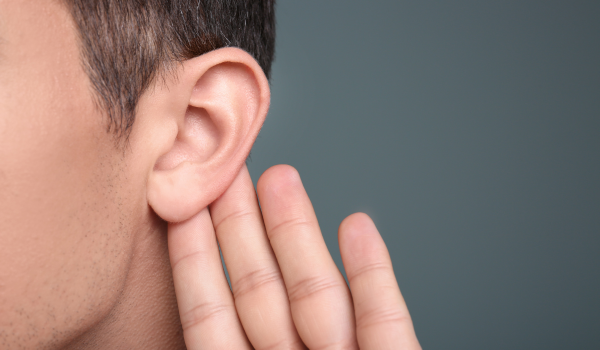.png)
Hearing loss affects millions of people globally and can significantly impact communication, emotional well-being, and quality of life. There are several types of hearing loss, each linked to different parts of the ear. Understanding the distinctions between conductive, sensorineural, and mixed hearing loss is essential for diagnosis, treatment, and management.
Let’s explore each type in detail.
Conductive Hearing Loss
What It Is
Conductive hearing loss occurs when sound waves cannot effectively travel through the outer ear or middle ear to the inner ear. The issue lies in the mechanical transfer of sound.
Causes
Several conditions can block or damage the structures involved in conducting sound:
-
Earwax buildup (cerumen impaction)
-
Fluid in the middle ear due to colds or infections
-
Perforated eardrum
-
Otosclerosis (abnormal bone growth in the middle ear)
-
Eustachian tube dysfunction
-
Congenital malformations of the outer or middle ear
-
Foreign objects in the ear canal
Symptoms
People with conductive hearing loss may report:
-
Muffled or softer sounds
-
Trouble hearing faint sounds
-
Better hearing in noisy environments
-
Ear pain or pressure (depending on the cause)
Diagnosis
An audiologist or ENT (ear, nose, and throat) specialist may use:
-
Otoscopic examination
-
Tuning fork tests (e.g., Rinne and Weber)
-
Pure-tone audiometry
-
Tympanometry
Treatment Options
Most cases of conductive hearing loss are treatable:
-
Removal of earwax or foreign objects
-
Antibiotics for infections
-
Surgical repair of the eardrum
-
Insertion of pressure equalization tubes
-
Hearing aids, especially bone-conduction types
Sensorineural Hearing Loss
What It Is
Sensorineural hearing loss (SNHL) occurs when there is damage to the inner ear (cochlea) or the auditory nerve pathways leading to the brain. This type is permanent in most cases.
Causes
Common causes of sensorineural hearing loss include:
-
Aging (presbycusis)
-
Noise exposure (acute or chronic)
-
Head trauma
-
Inner ear infections
-
Ototoxic medications (e.g., certain antibiotics or chemotherapy drugs)
-
Genetic conditions
-
Meniere’s disease
-
Acoustic neuroma (a benign tumor on the auditory nerve)
Symptoms
Symptoms are typically more persistent and include:
-
Difficulty understanding speech, especially in noisy environments
-
Perception of muffled sounds
-
Tinnitus (ringing in the ears)
-
Sudden or gradual hearing loss in one or both ears
Diagnosis
Audiologists use advanced tests such as:
-
Pure-tone audiometry
-
Speech recognition tests
-
Otoacoustic emissions (OAE)
-
Auditory brainstem response (ABR)
Treatment Options
While sensorineural hearing loss is usually not reversible, management options include:
-
Hearing aids
-
Cochlear implants (for severe to profound SNHL)
-
Assistive listening devices (ALDs)
-
Lip-reading and auditory training
-
Sound therapy for tinnitus
Mixed Hearing Loss
What It Is
Mixed hearing loss combines elements of both conductive and sensorineural hearing loss. Damage is present in both the outer/middle ear and the inner ear or auditory nerve.
Causes
Mixed hearing loss can develop from:
-
Chronic ear infections that lead to inner ear damage
-
Head trauma affecting multiple parts of the ear
-
Aging-related inner ear damage combined with conductive issues
-
Congenital deformities affecting various ear structures
Symptoms
People may experience a mix of:
-
Muffled sounds
-
Reduced clarity of speech
-
Tinnitus
-
Feeling of fullness or pressure in the ear
Diagnosis
Testing typically reveals:
-
Conductive loss in combination with sensorineural deficits
-
Poor performance on both air conduction and bone conduction tests
Treatment Options
A combination of treatments may be used:
-
Medical treatment for the conductive portion (e.g., antibiotics, surgery)
-
Amplification devices for the sensorineural part
-
Hearing rehabilitation programs
-
Ongoing monitoring of hearing thresholds
Comparison by Location of Damage
| Type | Affected Area | Reversibility | Treatment |
| Conductive | Outer or middle ear | Often reversible | Medical/surgical intervention |
| Sensorineural | Inner ear or auditory nerve | Usually permanent | Hearing aids, implants |
| Mixed | Outer + inner or nerve damage | Partially reversible | Combined approach |
Risk Factors Across All Types
Although the causes vary, several risk factors can increase the likelihood of developing any form of hearing loss:
-
Exposure to loud noises
-
Chronic ear infections
-
Family history of hearing loss
-
Aging
-
Use of ototoxic drugs
-
Trauma to the head or ears
When to See a Hearing Specialist
Early detection leads to better outcomes. You should consult a hearing professional if you experience:
-
Sudden or gradual hearing loss
-
Constant ringing or buzzing in the ears
-
Difficulty understanding speech
-
Sensitivity to loud sounds
-
Ear pain or fullness
Timely assessment can help determine the type of hearing loss and the most appropriate course of action.
Living With Hearing Loss
Hearing loss, regardless of type, can be life-altering. However, with today’s technology and support systems, individuals can maintain a high quality of life. Tips for adapting include:
-
Use of hearing aids or cochlear implants
-
Learning communication strategies
-
Using closed-captioning tools
-
Seeking support groups or therapy
-
Creating a hearing-friendly environment
Preventing Hearing Loss
Although not all types are preventable, especially sensorineural loss due to aging or genetics, you can reduce your risk by:
-
Avoiding prolonged exposure to loud sounds
-
Using ear protection in noisy environments
-
Keeping ears clean, but avoiding excessive cleaning
-
Managing chronic conditions (e.g., diabetes, hypertension)
-
Regular hearing screenings
Final Thoughts
Understanding the different types of hearing loss helps individuals recognize symptoms early and seek effective interventions. Whether the cause lies in the outer, middle, or inner ear, modern diagnostics and treatments offer a better quality of life to those affected. Awareness and education are the first steps toward prevention and care.

.png)

.png)
.png)
.png)


